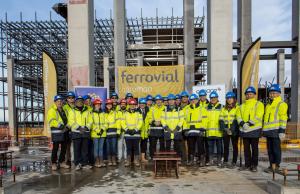On site
Strategic and symbolic buildings change hands
7 Jan 2019
Constructing and delivering the installation's buildings to the ITER Organization is a major part of Europe's contribution to the ITER Project.
Director-General Bernard Bigot (centre) stressed the symbolic importance of the buildings, which are all part of the installation's heat rejection system. To the right: Laurent Schmieder, of Fusion for Energy, who led the construction of the buildings; to the left: Alberto Lopez of the contractor Ferrovial.
On Friday 21 December 2018, the last working day of the year, an important milestone was passed as a large area on the north of the platform was handed over to the ITER Organization by the European Domestic Agency Fusion for Energy.
"There is something highly symbolic in the nature of the buildings we are receiving today," said ITER Director-General Bernard Bigot in his address. "They all belong to the installation's heat rejection system and they are what makes ITER unique among fusion machines — a tokamak that will produce considerable amounts of energy for a significant duration and overpass the breakeven of input/output ratio."
Representatives of the ITER Construction Department, the Buildings and Infrastructure and Power Supply project team (BIPS)—with Engage working as Architect Engineer and Apave as support on worker health and safety. An average of 50 staff from contractor Ferrovial-Agroman were involved in civil works for over three years.
Designing and fabricating the high-performance system that will evacuate the heat generated by the ITER plasmas was part of India's contributions to ITER; building the concrete basins and infrastructure was the work of Europe, and installing the equipment will be the responsibility of the ITER Organization.
For Director-General Bigot, this realization was "yet another clear demonstration of the One Team spirit and ITER values among all the stakeholders."



